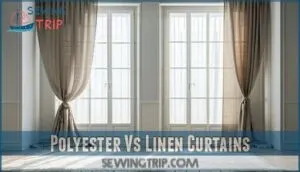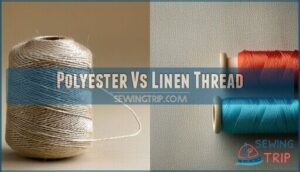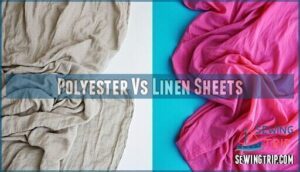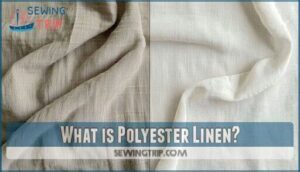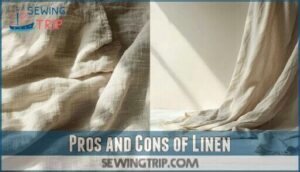This site is supported by our readers. We may earn a commission, at no cost to you, if you purchase through links.
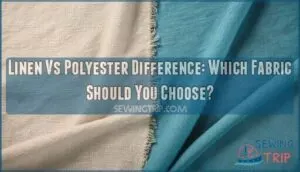
You’ll find linen breathes like a dream and gets softer with each wash, but it wrinkles faster than yesterday’s newspaper.
Polyester, on the other hand, keeps its shape, resists stains, and won’t break your budget, though it can feel stuffy on hot days.
Linen comes from flax plants and naturally regulates temperature, making it perfect for summer bedding and clothing.
Polyester’s lab-created fibers offer durability and easy care but trap heat.
Your choice depends on whether you prioritize comfort and breathability or low-maintenance practicality and longevity.
Table Of Contents
- Key Takeaways
- Is Polyester The Same as Linen?
- Differences Between Linen and Polyester
- Polyester Vs Linen Couch
- Polyester Vs Linen Curtains
- Polyester Vs Linen Tablecloths
- Polyester Vs Linen Headboard
- Polyester Vs Linen Thread
- Polyester Vs Linen Sheets
- What is Polyester Linen?
- Pros and Cons of Linen
- Frequently Asked Questions (FAQs)
- Conclusion
Key Takeaways
- You’ll find linen breathes naturally and regulates temperature perfectly for hot weather, while polyester traps heat but offers superior wrinkle resistance and stain protection for everyday use.
- Linen’s made from flax plants and biodegrades naturally, whereas polyester’s synthetic petroleum-based fibers contribute to microplastic pollution and take centuries to decompose.
- You’ll pay more upfront for linen due to labor-intensive production, but it gets softer and stronger over time, while polyester offers budget-friendly durability with consistent performance.
- Linen requires gentle care and wrinkles easily, demanding more maintenance time, but polyester’s machine-washable and low-maintenance, making it perfect for busy lifestyles.
Is Polyester The Same as Linen?
No, polyester and linen are completely different fabrics with distinct fiber composition and production processes.
Linen fabric comes from flax plants, making it a natural fiber that’s been around for thousands of years. You’ll find it’s breathable, absorbent, and gets softer with each wash.
Polyester fabric, on the other hand, is synthetic – created in labs from petroleum products through complex chemical processes.
The environmental impact differs dramatically too. Linen biodegrades naturally and requires minimal water during cultivation, while polyester contributes to microplastic pollution and takes centuries to decompose.
In terms of comfort factors, linen excels in hot weather due to its moisture-wicking properties, whereas polyester tends to trap heat. Polyester’s advantage is its superior fabric strength.
Cost analysis shows linen typically costs more due to labor-intensive production, while polyester offers budget-friendly durability and wrinkle resistance for everyday use.
Differences Between Linen and Polyester
Two fabrics couldn’t be more different in their DNA.
Linen vs polyester reveals stark material differences that’ll shape your buying decisions.
Linen’s natural flax fibers offer superior fabric breathability and soften beautifully over time, while polyester’s synthetic structure provides wrinkle resistance but traps heat.
Environmental impact weighs heavily—linen biodegrades naturally versus polyester’s landfill permanence.
Maintenance needs differ dramatically: linen requires gentle care, polyester tolerates machine washing.
Cost comparison favors polyester initially, though linen’s durability justifies investment.
Texture differences? Linen feels luxurious; polyester stays consistently smooth.
Polyester, unlike linen, has a smooth, synthetic feel.
Polyester Vs Linen Couch
Choosing the right couch fabric impacts your daily comfort and long-term satisfaction.
Linen fabric offers natural breathability and develops character over time, while polyester fabric provides consistent durability and easy maintenance.
Your lifestyle determines the best choice for couch comfort.
Given its construction, polyester offers superior abrasion resistance compared to linen.
| Feature | Linen Fabric | Polyester Fabric |
|---|---|---|
| Stain Resistance | Absorbs spills easily | Repels most liquids |
| Durability Comparison | Shows wear patterns | Maintains appearance |
| Cost Analysis | Higher upfront investment | Budget-friendly option |
| Best Usage | Low-traffic areas | High-traffic spaces |
| Maintenance | Professional cleaning | Machine washable |
This fabric comparison helps you make informed decisions based on your specific needs and preferences.
Polyester Vs Linen Curtains
When choosing curtains, you’ll find significant differences between linen and polyester that affect your daily comfort.
Linen curtains offer superior breathability and natural drape quality, creating an elegant aesthetic appeal that polyester simply can’t match.
However, polyester excels in durability and wrinkle resistance.
Considering curtains as a <strong>long term investment</strong> is important because they’re used regularly.
| Feature | Linen Curtains | Polyester Curtains |
|---|---|---|
| Light Filtration | Natural, soft filtering | Consistent, adjustable opacity |
| Privacy Levels | Moderate coverage | Excellent privacy control |
| Insulation Properties | Minimal thermal benefits | Superior energy efficiency |
| Drape Quality | Graceful, natural flow | Structured, consistent hanging |
Your fabric comparison should consider maintenance needs.
Polyester curtains resist stains and fade less, while linen requires gentle care but develops beautiful character over time.
Polyester Vs Linen Tablecloths
When setting up for special occasions, you’ll face the classic linen vs polyester tablecloth dilemma. These fabric choices couldn’t be more different in their approach to dining elegance.
| Feature | Linen Properties | Polyester Properties |
|---|---|---|
| Aesthetic Appeal | Natural texture, sophisticated drape | Smooth, uniform appearance |
| Stain Resistance | Absorbs spills, requires spot treatment | Repels liquids, easy cleanup |
| Formal Settings | Premium choice for elegant events | Suitable for casual gatherings |
| Cost Comparison | Higher price point, investment piece | Budget-friendly, affordable option |
| Maintenance Needs | Wrinkles easily, gentle care required | Machine washable, low maintenance |
Linen’s natural breathability creates comfort during long dinner parties, while its refined texture complements fine china beautifully. Polyester wins the practicality game with superior stain resistance and wrinkle-free convenience.
For formal settings, linen’s sophisticated appeal justifies the higher cost. However, polyester’s easy maintenance makes it perfect for everyday dining or outdoor events where spills happen frequently.
Opting for linen also means choosing a fabric that’s eco-friendly and biodegradable, contributing to sustainable practices.
Polyester Vs Linen Headboard
Your bedroom sanctuary deserves thoughtful fabric choices for headboard comfort and lasting appeal.
Linen headboards breathe naturally, wicking moisture while you sleep, but they’ll wrinkle easily and need gentle care. Polyester headboards resist wrinkles and stains, making cleaning ease a breeze with simple vacuuming.
Both materials are also used in industrial applications, but polyester offers low elongation.
| Feature | Linen | Polyester |
|---|---|---|
| Aesthetic appeal | Natural texture, sophisticated look | Smooth, consistent finish |
| Fabric durability | Softens over time, prone to wrinkles | Maintains shape, may pill eventually |
| Cleaning ease | Requires gentle laundering, air drying | Machine washable, stain resistant |
| Cost comparison | Higher investment, premium material | Budget-friendly, affordable option |
Choose linen vs polyester based on your priorities: natural elegance or practical maintenance. Consider the aesthetic appeal, fabric durability, and cleaning ease to make an informed decision, and remember that polyester is a budget-friendly option with low elongation.
Polyester Vs Linen Thread
When selecting thread for your sewing projects, you’ll discover significant differences between linen and polyester options.
Linen thread originates from flax plant fibers, offering exceptional thread strength that actually increases when wet.
This natural durability makes it perfect for outdoor gear and demanding sewing applications.
Polyester thread, derived from petroleum-based materials, provides consistent synthetic performance with superior colorfastness.
While linen costs more due to complex production, polyester offers affordable reliability for everyday projects.
For general use, consider that polyester threads offer versatility for various applications.
| Feature | Linen Thread | Polyester Thread |
|---|---|---|
| Durability | Stronger when wet | Consistent strength |
| Best uses | Outdoor gear, artisan work | General sewing, industrial |
| Biodegradability | Completely biodegradable | Non-biodegradable |
Your choice depends on project requirements.
Linen thread delivers traditional craftsmanship with environmental benefits, while polyester thread guarantees reliable performance across various sewing applications.
Polyester Vs Linen Sheets
Two fundamental questions shape your sheet selection: comfort or convenience?
Linen sheets deliver exceptional sheet breathability through their loose weave, making them perfect for hot sleepers and seasonal use during summer months. The natural flax fibers excel at moisture-wicking, enhancing sleeping comfort substantially.
Polyester sheets trap heat but offer wrinkle resistance and quick drying. Polyester’s moisture resistance makes it suitable for athletic wear, unlike linen.
| Feature | Linen Sheets | Polyester Sheets |
|---|---|---|
| Breathability | Excellent airflow | Poor ventilation |
| Durability | Decades with care | 5-7 years typical |
| Comfort | Softens over time | Consistent texture |
| Cost Comparison | $100-300+ | $20-80 |
| Weave Variations | Loose, textured | Tight, smooth |
Linen’s durability means higher upfront costs pay off long-term. Your sleep temperature preferences and budget determine the winner.
What is Polyester Linen?
You might encounter products labeled "polyester linen," but this term describes fabric blends rather than pure materials.
These hybrid fabrics combine synthetic fibers with natural linen to create cost-effective alternatives.
Here’s what you should know:
- Fabric blend composition – Typically 60-80% polyester mixed with linen fibers
- Hybrid properties – Merges polyester’s durability with linen texture appeal
- Cost analysis – Substantially cheaper than 100% linen while maintaining similar appearance
- Best uses – Home decor applications where frequent washing is required
- Environmental impact – Reduces linen’s biodegradability due to synthetic fiber content
These blends offer practical compromises for budget-conscious consumers.
Polyester’s strength provides superior fabric tension, making it ideal for these blends.
Pros and Cons of Linen
Natural fabric enthusiasts often find themselves weighing linen’s trade-offs carefully.
Natural fibers demand careful consideration—their beauty comes with unique challenges that synthetic alternatives simply don’t present.
You’ll love linen’s exceptional breathability and comfort during warm weather, plus its impressive durability that actually strengthens when wet.
This sustainable fabric choice supports eco-friendly living while developing beautiful character over time.
However, linen care demands attention—it wrinkles easily and requires gentle washing.
Linen cost runs higher than synthetic alternatives, and you’ll need to budget for proper maintenance.
Despite these challenges, linen offers thermoregulation, keeping you comfortable in both heat and cold.
Despite these challenges, linen durability and timeless appeal make it worthwhile for many homeowners.
Frequently Asked Questions (FAQs)
How Do I Get Wrinkles Out of Linen?
Iron damp linen on medium-high heat using a pressing cloth, or hang it while slightly wet to air-dry smooth.
You can also use a steamer for gentler wrinkle removal without direct heat contact.
What’s the Best Way to Clean Polyester?
Machine wash polyester in warm water with regular detergent.
It’s wrinkle-resistant, so you won’t need much ironing. Use low heat if needed.
Polyester dries quickly and resists stains, making cleanup a breeze.
Which is More Durable, Linen or Polyester?
Surprisingly, polyester wins the durability battle despite being synthetic.
You’ll find it resists stretching, shrinking, and tearing better than linen, though linen actually gets stronger when wet and softens beautifully over time, which is a notable characteristic.
How Do I Prevent Linen From Shrinking When Washing?
Always wash linen in cold water and air dry it completely.
Don’t use hot water or machine drying, as heat causes fibers to contract.
Pre-wash new linen items to remove any residual shrinkage before first use.
Is Linen or Polyester Better for People With Allergies?
Like a gust of cool breeze, linen’s your best friend if you’ve got allergies.
It’s hypoallergenic and naturally repels dust mites, while polyester can trap allergens.
Choose linen for cleaner breathing.
Which is better, linen or polyester?
Neither fabric is universally "better" – it depends on your priorities. Choose linen if you value breathability, sustainability, and natural luxury. Pick polyester for durability, easy care, and budget-friendly options.
What is the disadvantage of linen?
Linen’s main drawbacks include excessive wrinkling, requiring frequent ironing, higher costs.
Potential issues with linen also include potential shrinkage if improperly washed, susceptibility to stains.
Additionally, linen demands gentle care routines that make maintenance more time-consuming than synthetic alternatives.
Is linen made out of polyester?
Ironically, you might think these fabrics are related, but linen isn’t made from polyester at all.
Linen comes from flax plants, while polyester‘s a synthetic material created from petroleum products in laboratories.
Is linen or polyester thread stronger?
Polyester thread packs more punch in the strength department.
You’ll find it boasts higher tensile strength than linen, resisting stretching and breaking better.
However, linen’s got its own superpower – it actually gets stronger when wet.
How do I get wrinkles out of linen?
Iron your linen while it’s still slightly damp using medium-high heat.
You can also steam it, hang it in a steamy bathroom, or use a spray bottle to dampen stubborn wrinkles before pressing.
Conclusion
Ironically, choosing between these fabrics isn’t really a choice at all—it’s about matching your lifestyle needs.
The linen vs polyester difference ultimately comes down to your priorities: breathable comfort versus practical durability.
You’ll love linen’s natural feel and temperature regulation for luxury applications, while polyester’s stain resistance and easy care make it perfect for high-traffic areas.
Consider your budget, maintenance preferences, and intended use to make the smartest fabric decision for your specific situation.


